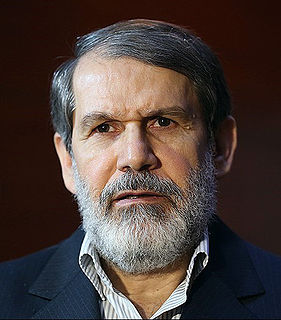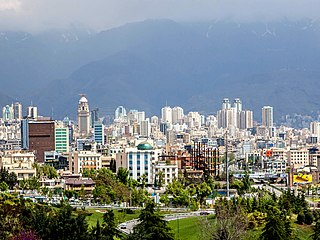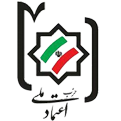
Akbar Hashemi Rafsanjani was an influential Iranian politician, writer and one of the founding fathers of the Islamic Republic who was the fourth President of Iran from 3 August 1989 until 3 August 1997. He was the head of the Assembly of Experts from 2007 until 2011, when he decided not to nominate himself for the post. He was also the chairman of the Expediency Discernment Council.

Hussein-Ali Montazeri was an Iranian Shia Islamic theologian, Islamic democracy advocate, writer and human rights activist. He was one of the leaders of the Iranian Revolution in 1979. He was once the designated successor to the revolution's Supreme Leader Ayatollah Khomeini, with whom he had a falling-out in 1989 over government policies that Montazeri claimed infringed on people's freedom and denied them their rights. Montazeri spent his later years in Qom, and remained politically influential in Iran, especially to the reformist movement. He was widely known as the most knowledgeable senior Islamic scholar in Iran and a Grand Marja of Shia Islam.

The Iranian parliamentary elections of February 20 and May 7, 2004 were a victory for Islamic conservatives over the reformist parties. Assisting the conservative victory was the disqualification of about 2500 reformist candidates earlier in January.

The Iranian reformists are a political faction in Iran that support former President Mohammad Khatami's plans to change the Iranian political system to include more freedom and democracy. Iran's "reform era" is sometimes said to have lasted from 1997 to 2005—the length of Khatami's two terms in office. The Council for Coordinating the Reforms Front is the main umbrella organization and coalition within the movement; however, there are reformist groups not aligned with the council, such as the Reformists Front.

Ali Larijani is an Iranian conservative politician, philosopher and former military officer who has been Speaker of the Parliament of Iran since 2008. Larijani was the Secretary of the Supreme National Security Council from 15 August 2005 to 20 October 2007, appointed to the position by President Mahmoud Ahmadinejad, replacing Hassan Rouhani. Acceptance of Larijani's resignation from the secretary position was announced on 20 October 2007 by Gholamhossein Elham, the Iranian government's spokesman, mentioning that his previous resignations were turned down by President Ahmadinejad.

Iran's ninth presidential election took place in two rounds, the first on 17 June 2005, the run-off on 24 June. Mohammad Khatami, the previous President of Iran, stepped down on 2 August 2005, after serving his maximum two consecutive four-year terms according to the Islamic Republic's constitution. The election led to the victory of Mahmoud Ahmadinejad, the hardline mayor of Tehran, with 19.48% of the votes in the first round and 61.69% in the second. Factors thought to have contributed to Ahmadinejad's victory include mobilization of mosque networks and conservative/hardline voters, and a protest vote against corrupt elite insiders and for "new political blood". A loyal supporter of conservative Supreme Leader Khamenei, Ahmadinejad kissed the leader's hand during his authorization ceremony. Officials reported a turnout of about 59% of Iran's 47 million eligible voters, a decline from the 63% turnout reported in the first round of balloting a week before.

Mehdi Karroubi is an Iranian Shia cleric and reformist politician leading the National Trust Party. He was the speaker of the parliament from 1989 to 1992 and 2000 to 2004, and a presidential candidate in the 2005 and 2009 presidential elections.

Mir-Hossein Mousavi Khameneh is an Iranian reformist politician, artist and architect who served as the seventy-ninth and last Prime Minister of Iran from 1981 to 1989. He was a reformist candidate for the 2009 presidential election and eventually the leader of the opposition in the post-election unrest. Mousavi served as the president of the Iranian Academy of Arts until 2009, when Conservative authorities removed him.

Mohammad Yazdi is an Iranian cleric who served as the head of Judiciary System of Iran between 1989 and 1999. In 2015, he was elected to lead Iran's Assembly of Experts, defeating Akbar Hashemi Rafsanjani, a former president, by a vote count of 47 to 24.

The Alliance of Builders or Developers of Islamic Iran, usually shortened to Abadgaran, was an Iranian conservative political federation of parties and organizations. Described as "Iran's neocons", main groups within the alliance were Front of Followers of the Line of the Imam and the Leader members and Society of Devotees of the Islamic Revolution.

The Office for Strengthening Unity, is an Iranian student organization created in 1979, and has been described as "the country's most well-known student organization," and "Iran's leading prodemocracy student group". Founded in 1979 as a conservative Islamist organization to combat leftist, more secular, student groups, the OSU has evolved to support democracy and reform in Iran and thus is now in opposition to the political heirs of its founders.
The Iranian Assembly of Experts election of 2006 was held on 15 December 2006. The Assembly of Experts is a Council of 86 mujtahids that elect the Supreme Leader, and oversee his actions. The members of the Assembly are elected every eight years directly by the people of Iran.
Iranian City and Village Councils elections, 2003 took place in February 2003, the second time local elections for city and village councils had taken place since being introduced in 1999, and 905 city and 34,205 village councils were up for election.

Iran's tenth presidential election was held on 12 June 2009, with incumbent Mahmoud Ahmadinejad running against three challengers. The next morning the Islamic Republic News Agency, Iran's news agency, announced that with two-thirds of the votes counted, Ahmadinejad had won the election with 62% of the votes cast, and that Mir-Hossein Mousavi had received 34% of the votes cast. There were large irregularities in the results and people were surprised by them, which resulted in protests of millions of Iranians, across every Iranian city and around the world and the emergence of the opposition Iranian Green Movement.

Sadegh Mahsouli is an Iranian politician who was Minister of Interior from 2008 to 2009 and Minister of Welfare and Social Security from 2009 to 2011. He was appointed to this post on 19 November 2009, as part of President Mahmoud Ahmadinejad's second cabinet after received vote of from Parliament. From 24 March 2008 to 9 August 2009, he was Minister of Interior of Ahmadinejad's first cabinet. He was succeed Ali Kordan who was impeached by Parliament in November 2008.

Protests against the highly controversial 2009 Iranian presidential election results, in support of opposition candidates Mir-Hossein Mousavi and Mehdi Karroubi, occurred in major cities nationwide from 2009 into early 2010. The protests were titled Iranian Green Movement by its proponents, reflecting Mousavi's campaign theme, and Persian Awakening, Persian Spring or Green Revolution, reflecting the "Persian identity" of Iranians and the so-called "colour revolution" theme.
The 2009 Iranian presidential election was characterized by huge candidate rallies in Iranian cities, and very high turnout reported to be over 80 percent. Iran holds a run-off election when no candidate receives a majority of votes, and this would have been held on 19 June 2009. At the closing of election polls, both leading candidates, Mahmoud Ahmadinejad and Mir-Hossein Mousavi, claimed victory, with both candidates telling the press that their sources have them at 58–60% of the total vote. Early reports had claimed a turnout of 32 million votes cast although the actual figure could not be determined until all of the votes were counted. Mousavi warned the Iranian people of possible vote fraud.

The parliamentary election for the 9th Islamic Consultative Assembly, or Majlis, were held in Iran on Friday, 2 March 2012 with a second round on 4 May 2012 in those 65 districts where no candidate received 25% or more of the votes cast. More than 5,000 candidates registered but more than a third were disqualified by the Guardian Council leaving about 3,400 candidates to run for the 290 seat representing the 31 provinces.

Parliamentary elections were held in Iran on 26 February 2016 to elect members of the Islamic Consultative Assembly for all seats in the 10th parliament in the Islamic Republic era and the 34th since the Persian Constitutional Revolution. A second round was held on 29 April 2016 for some constituencies where candidates failed to obtain the required minimum 25 percent of votes cast. The elected MPs will serve from May 28, 2016 to May 27, 2020.
The Council for Coordinating the Reforms Front or the Reformist Front Coordination Council is the umbrella organization, coalition and council of main political groups within the Iranian reform movement. Since 2015, it is overseen by the Reformists' Supreme Council for Policymaking.





















